Fractal Design Integra M 550W 80Plus Bronze Power Supply Review
Peter Donnell / 8 years ago
Introduction & Packaging
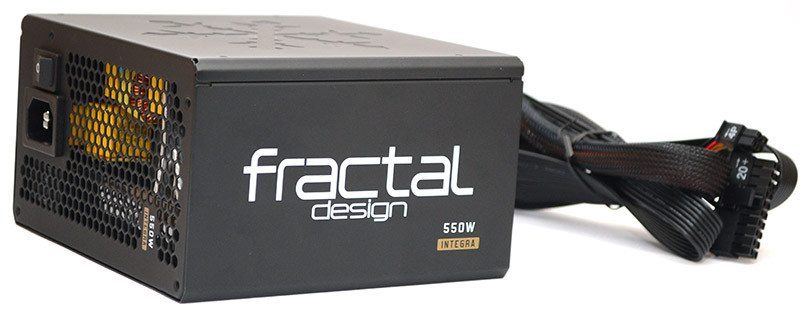
Fractal Design has been making high-end PC components for years, having already made a respectable name for themselves in the chassis market, making good ground in the PSU market and in the last couple of years, they’ve also been doing interesting things with water cooling too. Today, we are of course more interested in their PSU business, as we have their new 550W Integra in for review, a 80Plus Bronze rated semi-modular unit that is targeted at mid-range systems within a reasonably affordable budget range.
“Fractal Design Integra M units are equipped with a large temperature-controlled 120mm fan for reduced noise levels and optimum cooling. The Integra M is a great choice for medium-performance gaming computers and workstations.” – Fractal Design
Equipped with a compact 140mm form factor, this ATX power supply is well suited to chassis that has a compact design, and that should allow you more room for cable routing, longer graphics cards, cooling and more, dependant on your chassis configuration. Modular and flat style cables are also a big win, as they’re much easier to route and you can remove any cables you do not require, helping you achieve a much cleaner looking system build.
The Integra M ticks all the usual boxes, as you would expect any modern power supply to; OPP, OVP, UVP and SCP. You’ll also find good quality Taiwanese capacitors, bronze efficiency, a good quality 120mm fan, and a trusty 3-year warranty.
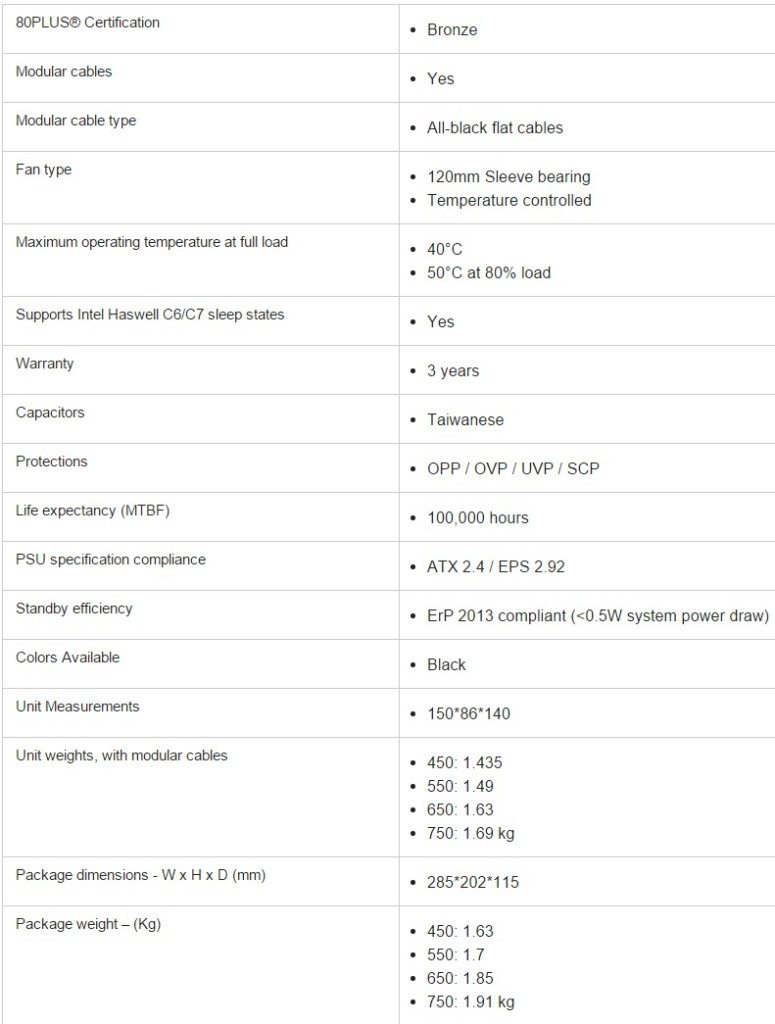
The packaging is nicely designed, as is always the case with Fractal Design products. On the front, we can see prominently displayed, the three years warranty, 80 Plus Bronze rating and the 550W power output.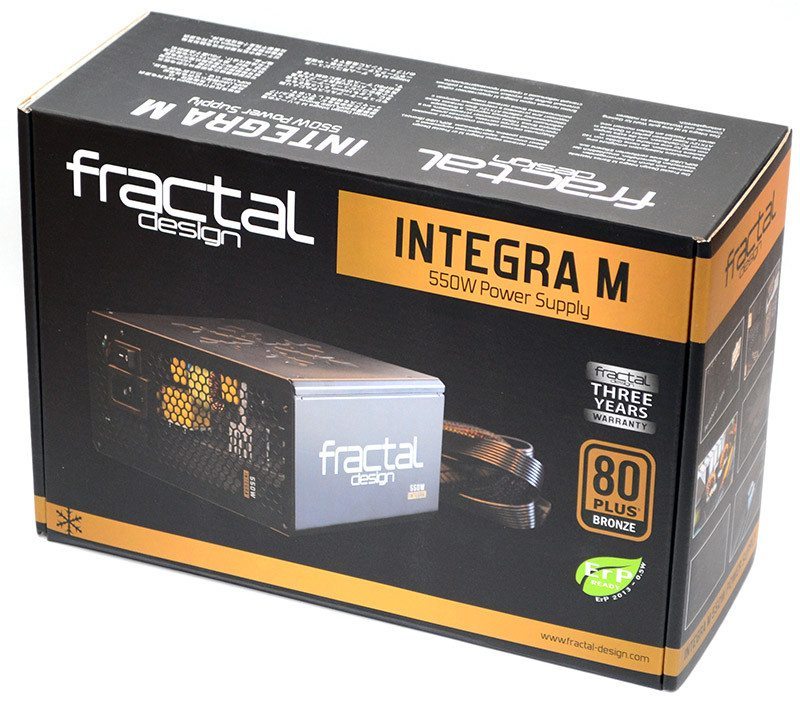
Around the back, a little technical information on the performance, although we’ll be testing this ourselves shortly, as well as information about the fixed and modular cables.
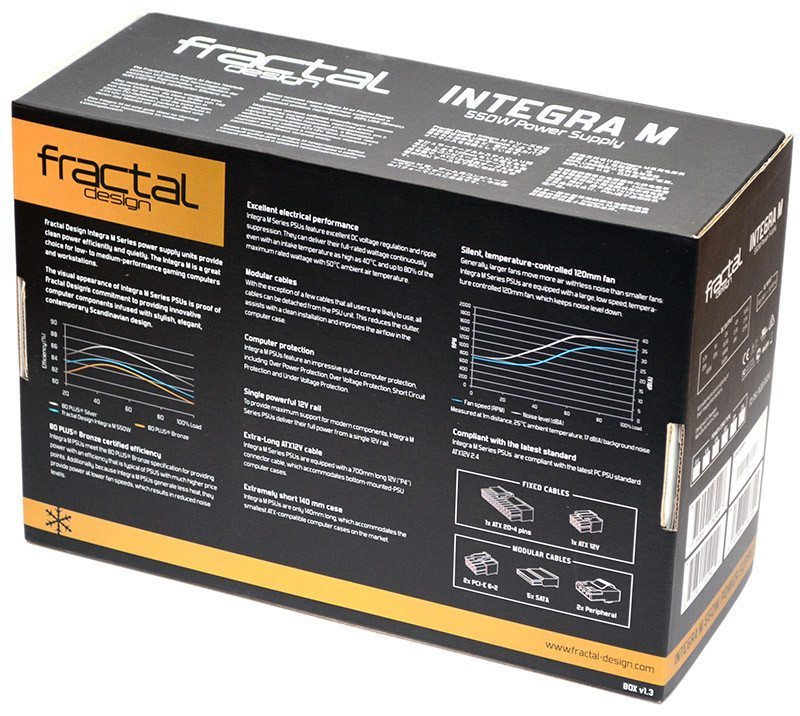
In the box, there’s a simple user guide, mounting screws, cable ties, a couple of velcro straps and the mains power cable.
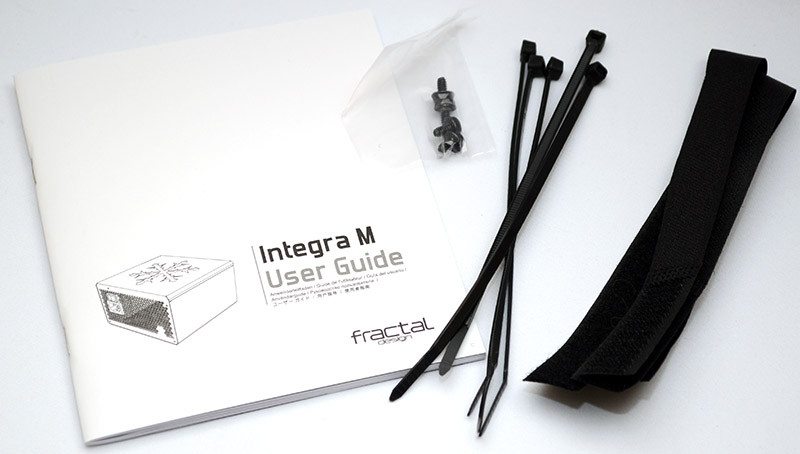
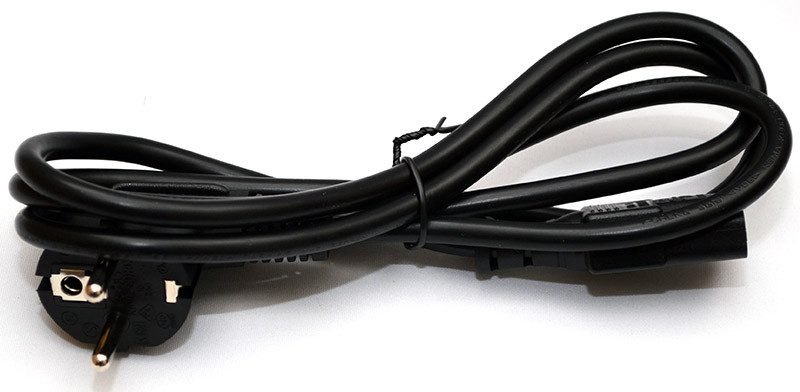
A Closer Look – Exterior
First impressions of the unit are promising, with a matte black finish that gives it a nice premium look, contrasted by the 120mm white fan behind the ample ventilation on the top.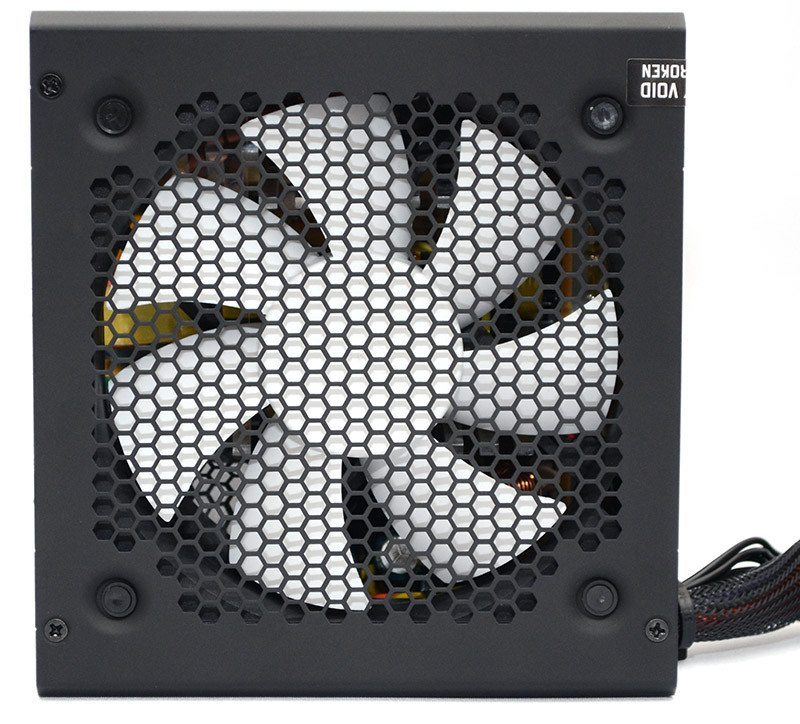
A nice Fractal Design logo on the side, smart enough to look nice when on show in your system.
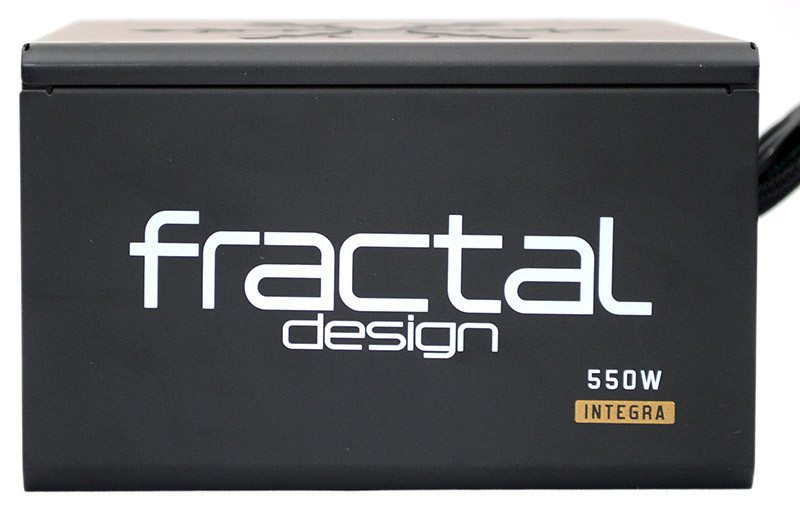
A rather cool Fractal Design frosty logo is embossed on the bottom of the PSU; this will look great when you inverse mount the PSU.
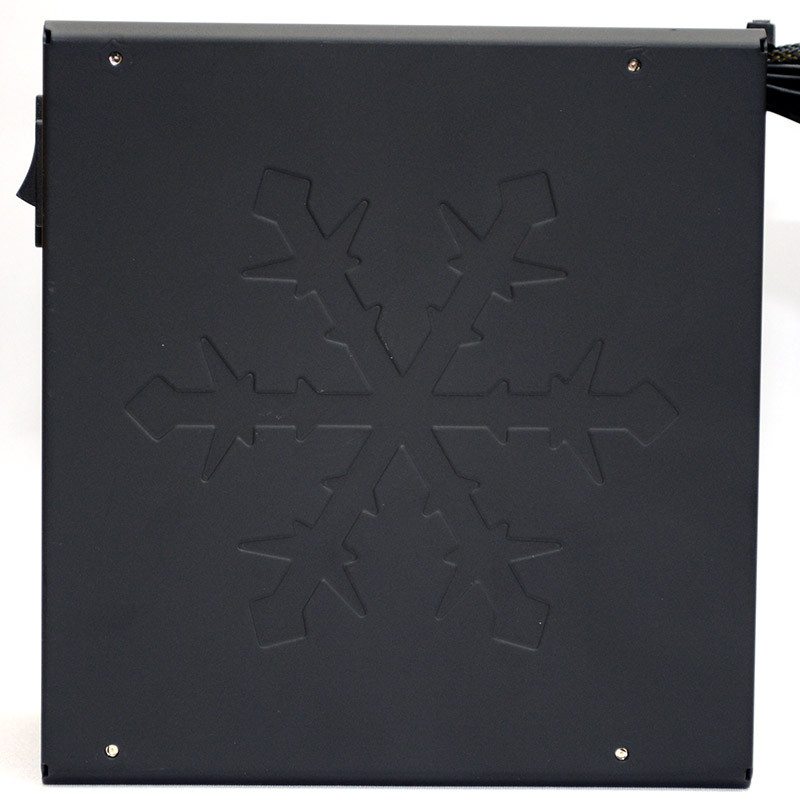
The main specifications are on the other side, as you can see, we’ve got a powerful 12V rail, so there should be no issues pushing power to a hungry graphics card.
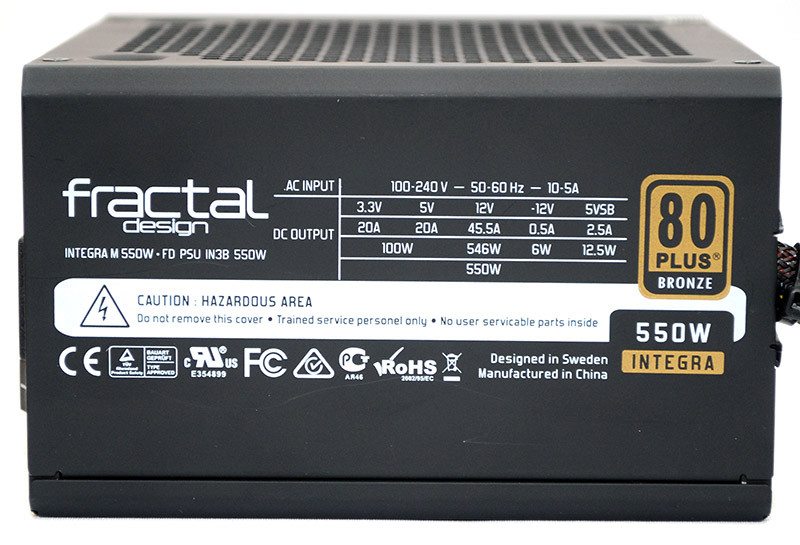
Around the back, you can see there’s a little extra ventilation at the top, as well as some modular connectors. The 24-pin and the 4+4 pin, which you’re absolutely going to need on any motherboard anyway, are hard-wired to the PSU.
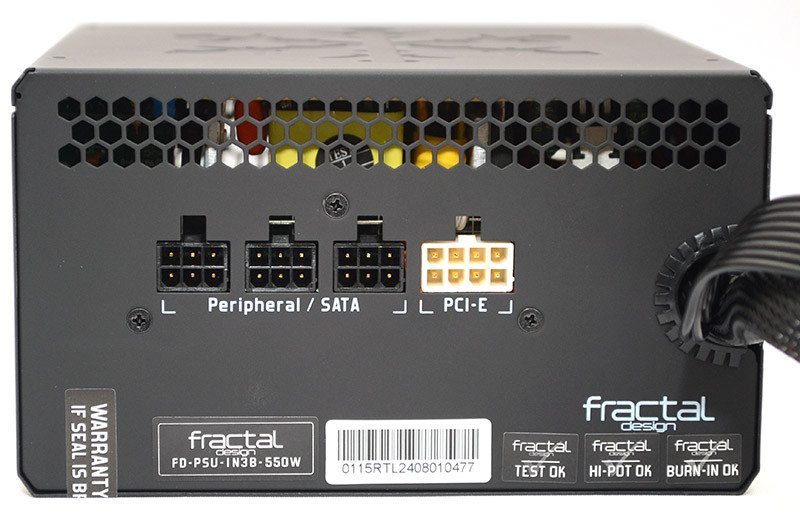
Around the back, even more ventilation, as well as the power socket and a most welcome master power switch for when you need to completely power down your system.
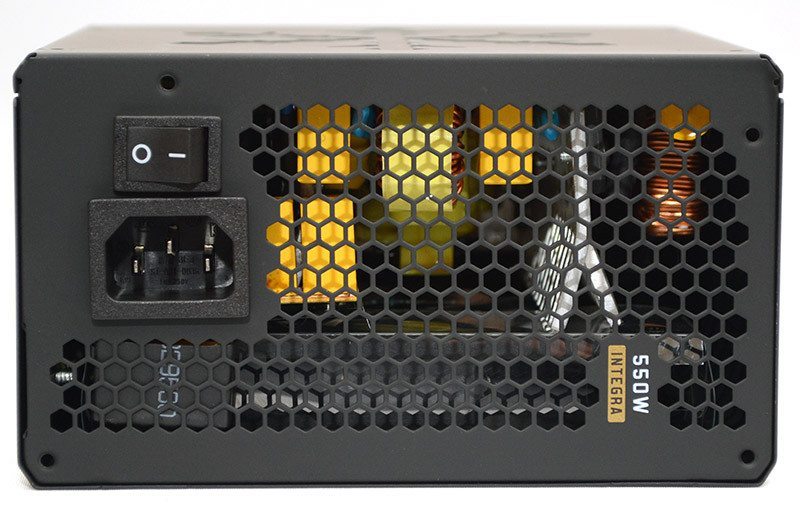
Cabling
There isn’t a lot of cables to deal with here, but you’ll find all the ones you’re likely to need. There’s a few Molex and SATA, as well as a dual 6+2 PCI-E cable.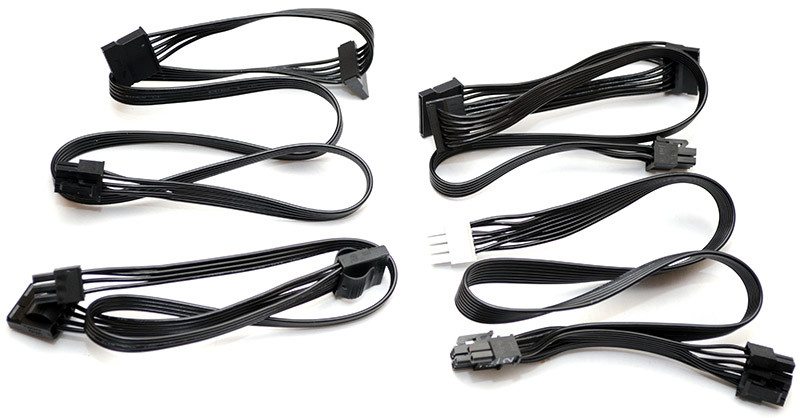
The motherboard power cables are nice and long, great for those using a full-tower chassis where the PSU mounts in the bottom, as this will still allow you to route the cables behind the motherboard.
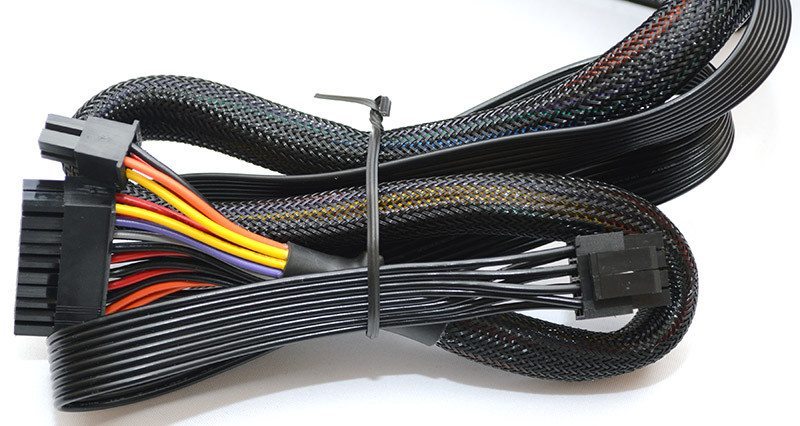
A Closer Look – Interior
The interior looks promising, with a good amount of spacing between all the vital components, which should help with overall airflow throughout the unit.
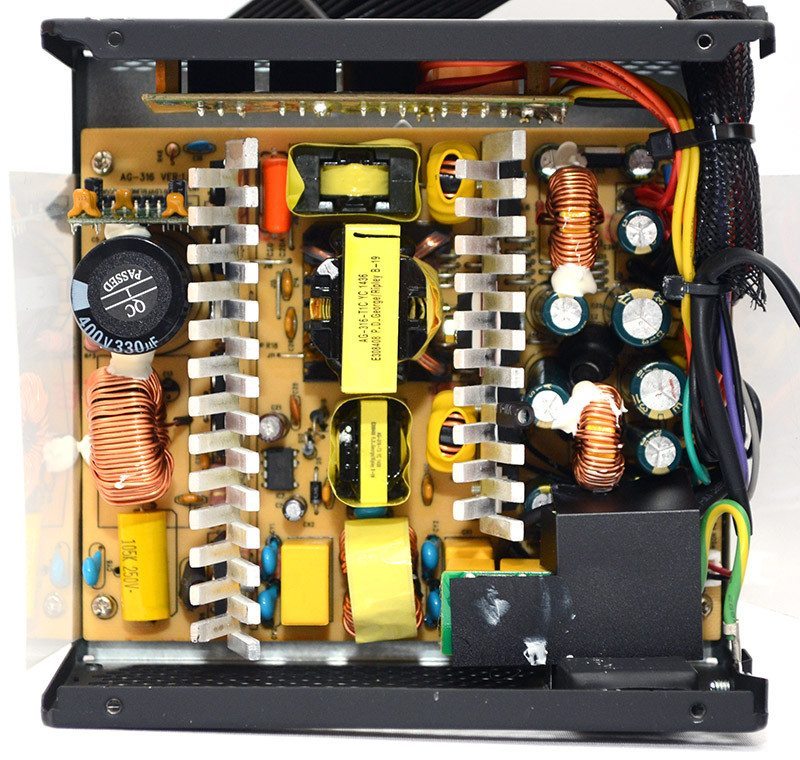
There’s a Teapo bulk capacitor, rated for 400V, 330uf @ 85c.
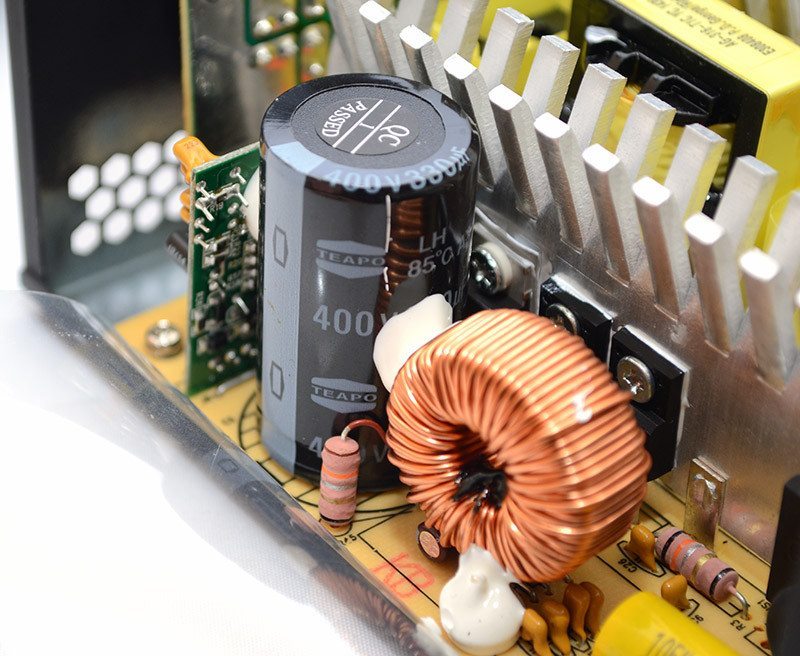
Two large heatsinks run down the middle sections of the unit, providing extra cooling for all the vital hardware and helping to break up the airflow from the fan for more efficient cooling.
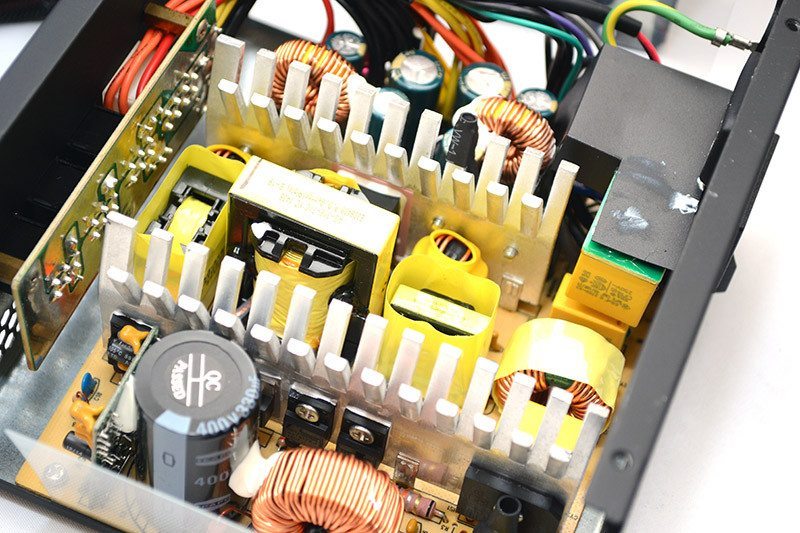
A small PCB towards the back for the modular connectors, with nice and clean soldering throughout.
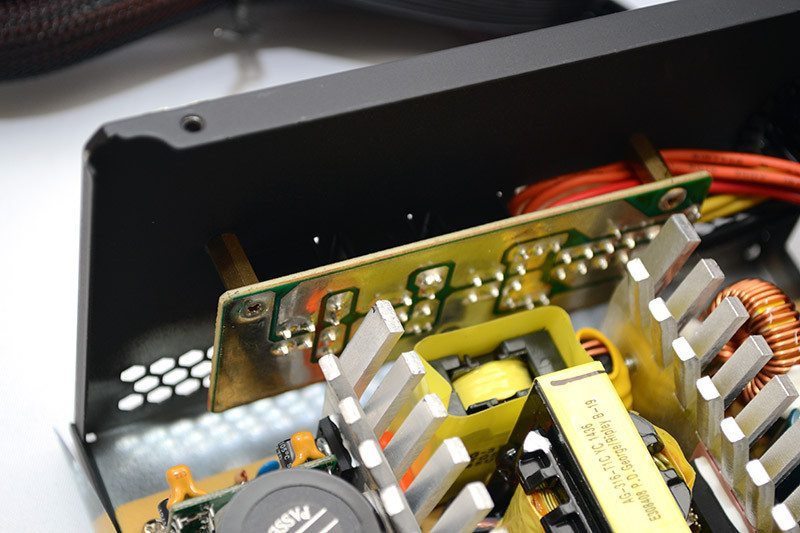
Any hard-wired cables are nicely secured, again with tidy soldering and it’s clear that a good amount of care has gone into the construction. There’s not a lot of excess cable here too, so it shouldn’t cause issues with cooling and airflow.
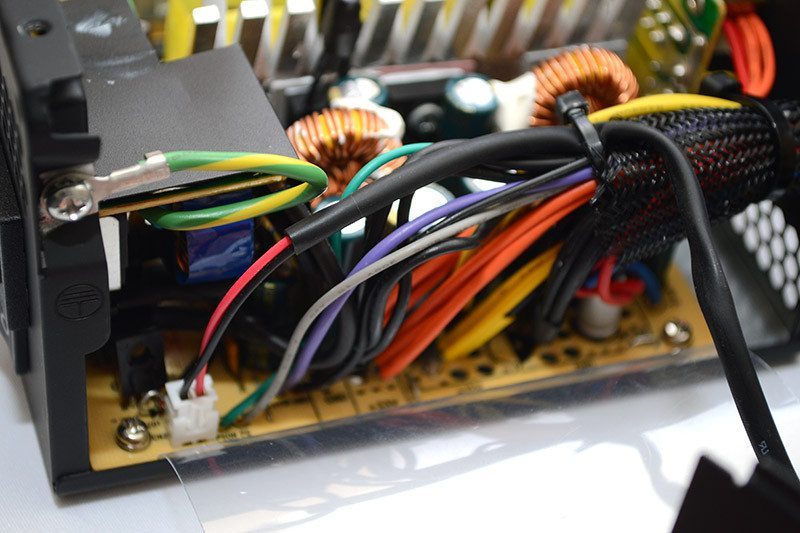
The secondary capacitors deal with all the other voltages in the unit and again, they’re all well spaced and neatly installed. There’s a little protective glue on the coils, helping ensure that if anything were to move inside the unit, they don’t catch and short-out.
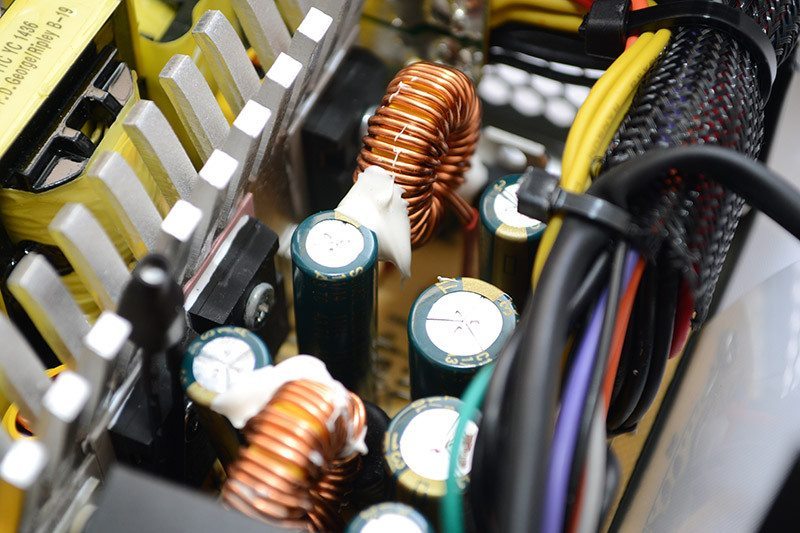
A carefully covered EM filter, which should help reduce any electrical noise or ripple.
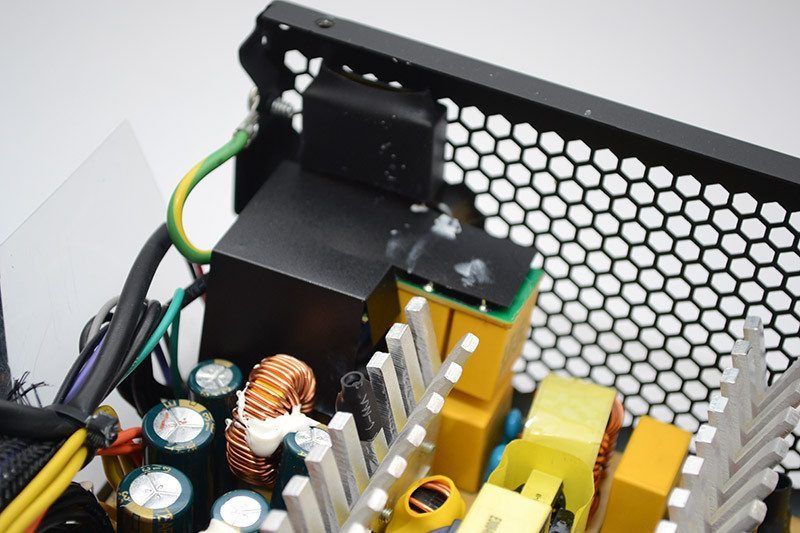
The fan is one of Fractal Design’s own sleeve bearing 12v models and it looks to be of a very good quality, especially for a PSU in this price range.
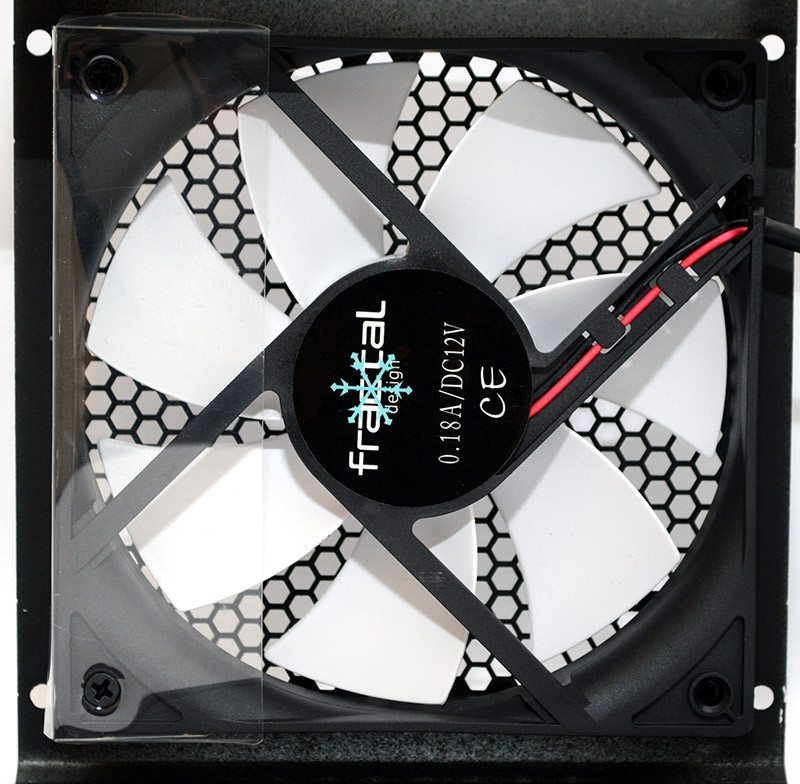
Test Procedure
At eTeknix we take the power supply testing procedure very seriously and have invested a lot of resources into acquiring the appropriate testing equipment. For all power supply reviews we test the power supplies with dedicated power supply testing equipment. This means we are able to get the most accurate results from our testing as opposed to using software benchmarks (such as OCCT) or multi-meter readouts which are broadly inaccurate.
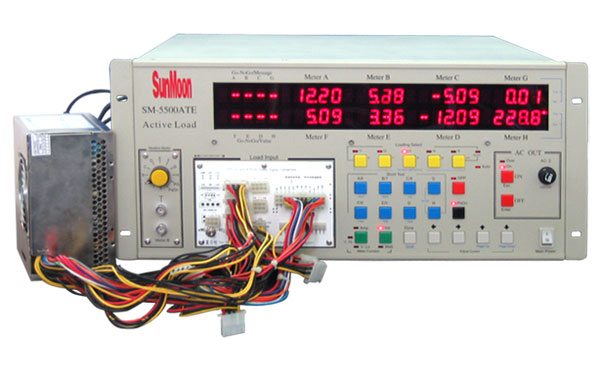
Our test machinery is as follows:
- Sunmoon SM-5500ATE Active Load Tester (1200W rated)
- Stingray DS1M12 USB Oscilloscope
- Voltcraft DT-10L laser tachometer
The eTeknix test procedure involves:
- Testing each power supply at 20/40/60/80/100% load (with balanced load across all rails) and measuring PFC (power factor correction), efficiency (actual power divided by power “pulled at the wall”) and voltage regulation (deviance from expected voltages of 3.3/5/12 on the main rails).
- Measuring ripple with an oscilloscope at 20/40/60/80/100% load.
- Measuring fan speed after a stabilisation period of five minutes at each load scenario using the Voltcraft DT-10L laser tachometer and a reflective strip on the fan.
- Testing each power supply’s OPP (Over Power Protection) mechanism and seeing how many watts each power supply can deliver before shutting down
Other things to consider are that
- We recognise that a single yellow 12 volt cable can provide only 6 Amps before overheating (which corrupts voltage regulation and efficiency) and so we used an adequate number of cables for each power supply to ensure there is not efficiency loss from poor cables selection
- Our Sunmoon SM-5500ATE power supply tester is not capable of testing more than 300W on each of the 12 volt rails so where a power supply provides more than 300W on a 12 volt rail that power is distributed over multiple 12 volt rails on the load tester. For example a power supply with one 12 volt rail supplying 750 watts would be spread equally over three 12 volt rails on the load tester, a power supply with two 450W 12v rails would be spread over four 12v rails on the load tester, two 225W 12v rails for each of the 12v rails on the unit.
- We use the same time scale and horizontal millivolt scale on our oscilloscope for all ripple tests, that is a 20ms T/DIV (horizontal) and a 0.02 V/DIV (vertical) meaning the scale is from -80mV to +80mV, ATX spec dictates that the 12v rail must fall within 150mv of ripple and the 3.3/5 within 50mv so that scale allows us to include both 150 and 50mV peaks. (Some older PSU reviews use different scales which were later ditched as the visual representation they give is inadequate, in these reviews written measurements are provided only).
- Deviance is the terminology used to represent the way voltages diverge from the expected values
Efficiency, PFC and Voltage Regulation
Voltage Regulation
To test voltage regulation we load the power supply to five different load scenarios that give an equal spread of load across every single rail. So that means 20% on all rails, 40% on all rails and so on. We then calculate the average deviance of each rail from its expected voltage.

The voltage regulation on this unit was fairly good, but certainly nothing too fancy. I generally aim for under % deviance, but the 5V rail was running a little hot, but still well within safe margins. The one that really matters, the 12V1 and 12V2 in this case, are nice and consistent and on par with what we would expect from a good quality unit.
Power Efficiency
Power efficiency is measured by calculating actual supplied wattage divided by the wattage drawn at the wall/plug, multiplied by 100 to give a percentage. We then compare that to the particular 80 Plus certification the company claims to see if it meets that. You can see the 80 Plus certifications below, we always test 230v power supplies.
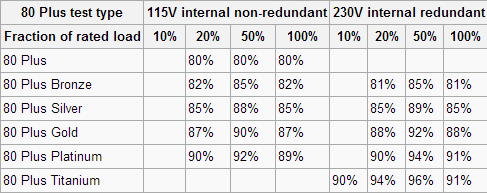
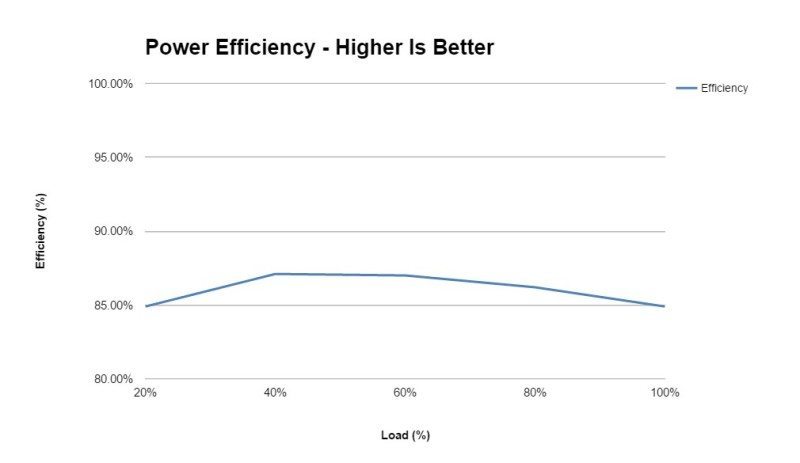
Efficiency is pretty consistent on this unit, never dropping below 85% and that’s well above the 81% required for Bronze rating and just stepping on the toes of the 80 Plus Silver classification.
Power Factor Correction
Power Factor Correction is the ratio of the real power flowing to the load, to the apparent power in the circuit. The aim of PFC is to make the load circuitry that is power factor corrected appear purely resistive (apparent power equal to real power). In this case, the voltage and current are in phase and the reactive power consumption is zero. The closer the number to one the better as this allows the most efficient delivery of electrical power (Source – Wikipedia).
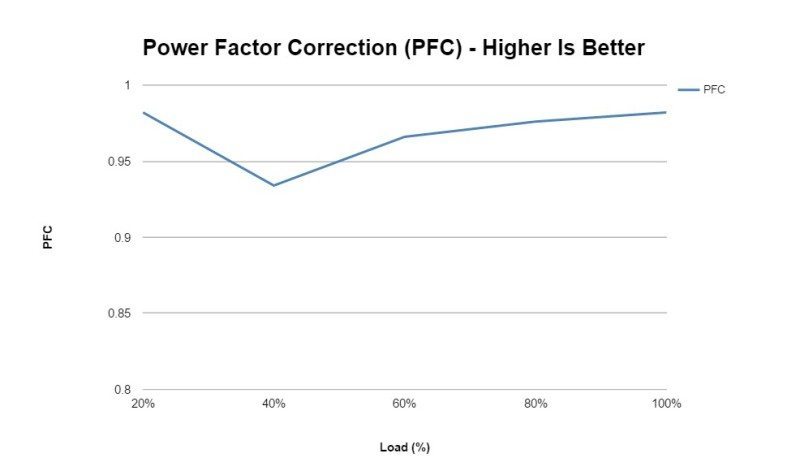
The PFC is pretty good overall, there’s a bit of a dip around 40%, not sure what happened there, but it’s still a good result and certainly nothing to worry about.
Ripple
Noise and Ripple can easily be measured by an oscilloscope. These show how much voltage fluctuation there is on a particular rail. We tested the rail stability of the 3.3 volt, 5 volt and 12 volt rails using an identical time and millivolt scale for all graphs. millivolt ripple is measured by the peak to peak size of the voltage curve.
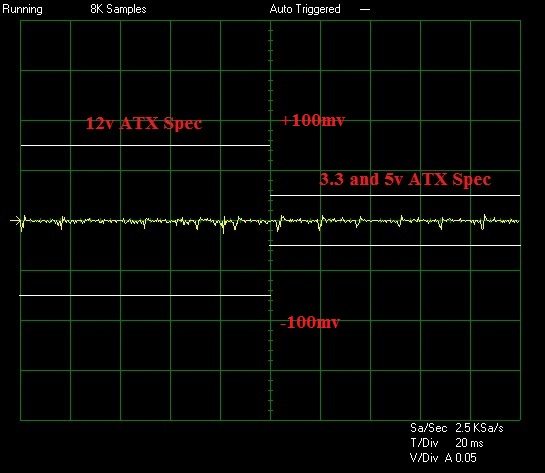
Sample Ripple Graph
The latest ATX 12 volt version 2.3 specifications state that ripple from peak to peak must be no higher than 50 millivolts for the 3.3 volt and 5 volt rails, while the 12 volt rail is allowed up to 120 millivolts peak to peak to stay within specifications. Millivolt figures are stated to the closest increment of 5 given their variability.
| Load (%) | 3.3V Ripple | 5V Ripple | 12V Ripple |
| 20 | 7 | 8.6 | 13 |
| 40 | 11.8 | 12.8 | 18.4 |
| 60 | 15 | 16.4 | 23.8 |
| 80 | 17.4 | 18.4 | 30.1 |
| 100 | 23.6 | 21 | 38.8 |
Ripple was quite high, or at least it’s a little higher than some other units in this price range. Of course, the rating for ripple is very easy to hit these days and these scores are still well within the desired range.
3.3 volt @ 100%
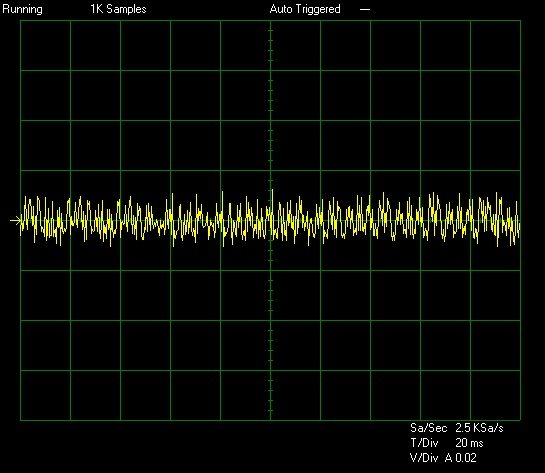
5 volt @ 100%
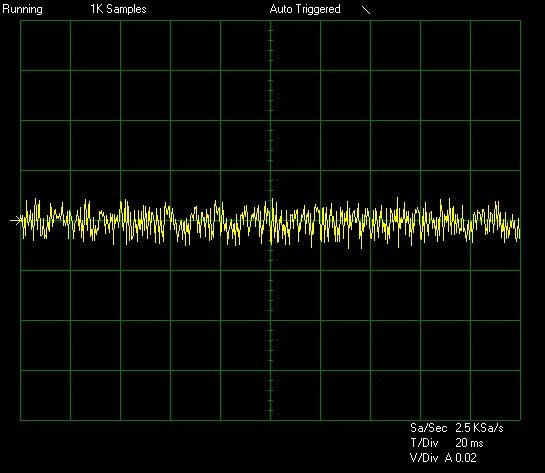
12 volt @ 100%
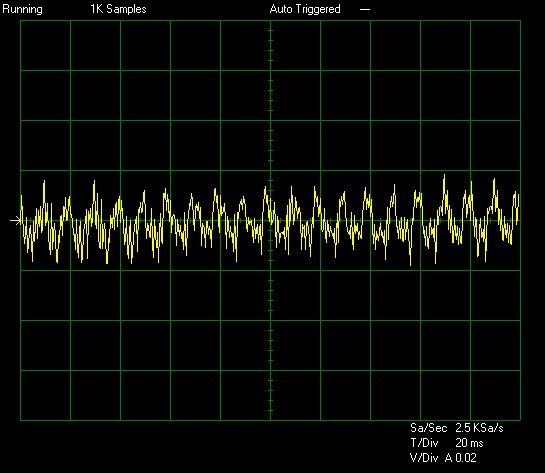
Over Power Protection and Max Wattage
Power supplies often quote as having various protection mechanisms such and the most important of these is Over Power Protection. In our testing we crank up the power draw until the power supply either shuts down (meaning the OPP mechanism is present and working) or blows up (meaning it is either not present or not working). We then note the maximum power consumption before the power supply shut down (or blew up).

For a unit of this size, I was expecting it to cap out somewhere in the low 600’s, but much to my surprise, this unit was able to pull a mighty 774W before the OPP kicked in. This is great news for gamers, as those big power spikes shouldn’t result in your system shutting down and let you keep the action going.
Fan Speed
When testing in a power supply laboratory it is difficult to take fan noise readings as the noise from the Sunmoon test equipment and air conditioning corrupts everything. The next best thing in our circumstances was reading off the fan speed with a tachometer to get an idea for the noise. The ambient temperature during testing held constant at 22 degrees, with 1 degree of variation. Each power supply had a consistent time period of 5 minutes to stabilise between each load scenario.
In my experience the following general relationships apply between noise levels and fan speeds, though it can vary greatly between the type of fan used.
- Below 800 RPM – Inaudible/Silent
- 800 to 1000 RPM – Barely audible
- 1000 – 1200 RPM – Audible but still quiet
- 1200 – 1400 RPM – Moderately noisy
- 1400 – 1800 RPM – Noisy
- 1800 RPM or higher – Intolerable
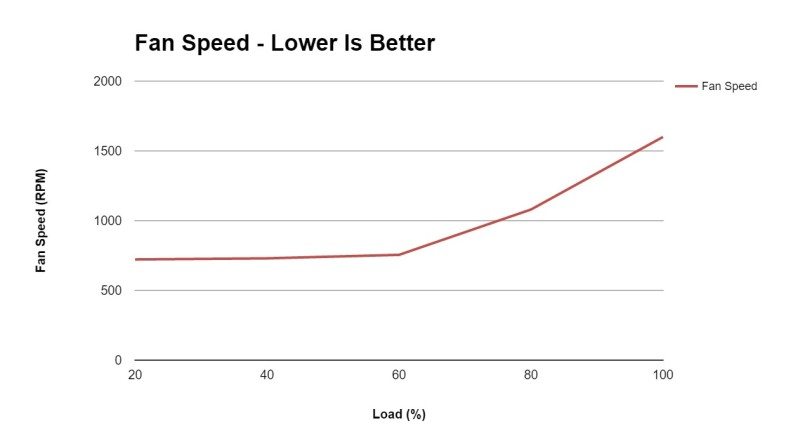
Fan speeds were pretty consistent all the way up to 80% load, never really going above 750RPM and running virtually silent. When we put some strain on the unit, the fan speed did have to pick up to keep the unit cool and there was some audible air turbulence at 100%, but it was still not as loud as we had expected it to be; it’s also unlikely you’ll be running this unit at full load for extended periods anyway.
Final Thoughts
Pricing
This is where the Fractal Design Integra shows off its greatest feature. Priced at around £50 from most major retailers, this is a great value for money unit given the range of features on offer and the overall design. We found one at CCL Computers for just £51.31, which is a very nice deal indeed.
Conclusion
The hardware specification of this power supply are nothing amazing, but it’s certainly ticking all the right boxes for anyone looking to build a new system, or even upgrade their current one. With semi-modular cables, as well as flat cables for the peripheral and PCI-E connectors, it’s going to help greatly with your cable management. There’s not a huge range of connections on offer, but for a smaller mini-ITX or Micro-ATX system build, office computer or HTPC, it’s going to give you everything you need and nothing you won’t need. With its short 140mm design, compatibility is going to be very high, allowing you to get it installed into some surprisingly compact chassis designs.
Design has always been one of the biggest advantages of Fractal Design products, and the Integra is no exception. This is a fantastic looking power supply, with a premium matte black finish, good quality cables and a high-quality white fan that contrasts nicely with the exterior of the unit. There’s only so much you can do with a PSU design, but this one should be a visual compliment to any system that it is installed in.
The build quality feels robust too and Fractal Design’s choice of internal components works well enough, not giving class leading results for ripple, but still well within the specifications. What did surprise me was the OPP, with the unit being able to pull well over 700w with ease, although this would result in the fan spinning a bit harder to keep it cool, it’ll certainly do it if and when you need it.
Overall, a very nice unit with reliable performance, good efficiency and a great price that is going to make it a tempting option from smaller chassis form factors and compact system builds.
Pros
- Good build quality
- Stylish design
- Semi-modular
- Flat cables
- Quiet fan
- Great OPP performance
- Good efficiency
- Competitive price
- Great chassis compatibility
Cons
- Ripple suppression could be improved

Fractal Design Integra M 550W 80Plus Bronze Power Supply Review
Thank you Fractal Design for providing us with this sample.



















